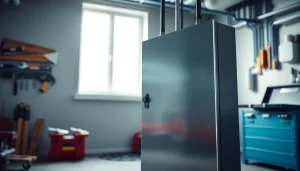Elevate Your Space with a Stunning Home Glass Greenhouse Addition

Understanding Home Glass Greenhouse Addition
What is a Home Glass Greenhouse Addition?
A home glass greenhouse addition is an extension of a residence designed primarily for gardening, where plants can be cultivated in a controlled environment. This structure utilizes glass as the primary building material to maximize sunlight exposure, allowing for optimal plant growth throughout the year. Unlike traditional greenhouses, these additions often blend seamlessly with the existing architecture of a home, providing aesthetic appeal alongside functionality. The growing popularity of such additions is attributed to their ability to enhance indoor gardening experiences while also contributing to the home’s overall value.
The Benefits of Incorporating a Greenhouse into Your Home
Integrating a home glass greenhouse addition into your property offers numerous benefits:
- Extended Growing Season: Glass greenhouses allow for year-round gardening, enabling plants to thrive even during colder months.
- Improved Plant Health: These structures maintain a controlled environment, minimizing the risk of pests, diseases, and extreme weather conditions that can harm plants.
- Increased Property Value: A well-designed greenhouse can significantly enhance the value of your home, making it more attractive to potential buyers.
- Aesthetic Appeal: A glass greenhouse adds a beautiful element to your outdoor area, providing a stunning view of your plants.
- Sustainability: Using a greenhouse encourages sustainable practices, as it allows for growing food at home, reducing the need for store-bought produce.
Types of Glass Greenhouses to Consider
When considering a glass greenhouse addition, you will encounter various styles that cater to different preferences and needs:
- Lean-To Greenhouses: Attached to the main structure, lean-to greenhouses are ideal for those with limited space. They utilize the existing walls of the home for support, allowing for easy access and integrated design.
- Free-Standing Greenhouses: These structures stand independently in the yard, allowing for greater design flexibility and solar efficiency. They can vary in size and shape, accommodating different gardening needs.
- Converted Sunrooms: Some homeowners opt to transform existing sunrooms into effective greenhouses, capitalizing on their already established space while enhancing light and ventilation.
- Custom Designs: For those looking for something unique, custom-designed greenhouses can be tailored to fit aesthetic preferences, local climate, and specific gardening goals.
Key Considerations for Your Home Glass Greenhouse Addition
Size and Space Requirements
One of the first steps in planning your home glass greenhouse addition is assessing the available space. Understanding the size and spatial requirements is crucial for ensuring that your greenhouse meets both your gardening goals and local zoning regulations. Consider the following:
- Available Yard Space: Evaluate your yard to determine how much space you can allocate to your greenhouse without compromising other areas, such as patios or gardens.
- Plant Variety: Different plants have varying space requirements. Plan your greenhouse size according to the number of plants you wish to grow and their specific growing needs.
- Future Expansion: Consider leaving some space for future expansions. If you find that your initial greenhouse meets your needs, you may wish to expand it later.
Material Options and Durability
Choosing the right materials for your greenhouse is essential for longevity and optimal plant growth. Common materials used in home glass greenhouses include:
- Tempered Glass: Known for its strength and resistance to thermal stress, tempered glass is a popular choice for greenhouses.
- Polycarbonate Panels: These panels are lightweight yet durable, providing excellent insulation and light transmission.
- Acrylic: While not as durable as glass, acrylic is an affordable and lightweight alternative that provides good light transmission.
The frame materials should also be considered, with aluminum, wood, and galvanized steel as viable options, each offering different benefits in terms of durability and aesthetics.
Climate Control and Ventilation
Effective climate control is vital for the success of a greenhouse. This involves not only temperature regulation but also ensuring proper ventilation to prevent overheating and humidity buildup. Here are essential features to consider:
- Ventilation Windows: Incorporating automated or manual ventilation windows can help regulate temperature and air circulation, promoting healthy plant growth.
- Heating Systems: In cooler climates, consider installing heating solutions such as electric or gas heaters to maintain optimal growing conditions.
- Cooling Systems: In warmer climates, cooling systems such as evaporative coolers and shade cloths can prevent temperature spikes during hot days.
Design Ideas for Home Glass Greenhouse Addition
Contemporary vs. Traditional Styles
The design of your greenhouse can reflect your personal style, integrating contemporary or traditional elements. A contemporary greenhouse often features clean lines and minimalist aesthetics, incorporating modern materials such as aluminum frames and polycarbonate panels. In contrast, traditional designs may utilize wooden frames and ornate details, blending seamlessly with classic architectural styles.
Integration with Outdoor Spaces
Integrating your greenhouse with the surrounding outdoor spaces enhances both functionality and beauty. Consider connecting pathways, creating a seating area nearby, or incorporating garden beds that complement the greenhouse environment. Transitioning from indoor to outdoor spaces can provide a more cohesive look and feel.
Creating a Functional Layout for Plants
A well-planned layout can significantly impact the efficiency of your greenhouse. Utilize vertical space by installing shelving and hanging pots, ensuring that light reaches all areas. Group plants by their watering and light needs, which can simplify care and promote healthier growth. Additionally, leaving room for pathways will facilitate movement and maintenance.
Building Your Home Glass Greenhouse Addition
Step-by-Step Installation Guide
Building a home glass greenhouse addition involves careful planning and execution. Follow these steps to ensure a successful installation:
- Planning and Design: Create a thoughtful design that considers size, layout, and materials.
- Obtaining Permits: Consult local authorities to obtain necessary building permits and adhere to zoning laws.
- Preparing the Site: Clear the designated area and level the ground for a flat foundation.
- Constructing the Base: Build a solid foundation using materials such as concrete, wood, or gravel to provide stable support.
- Framing: Assemble the frame using chosen materials, ensuring all connections are secure.
- Installing Glass Panels: Carefully install the glass panels or polycarbonate according to manufacturer instructions, ensuring proper sealing and insulation.
- Adding Features: Incorporate doors, ventilation, and climate control systems as needed.
- Finishing Touches: Complete the interior layout with shelving, potting areas, or grow lights.
Essential Features and Accessories
Beyond the basic structure, consider incorporating features and accessories that enhance functionality:
- Heating Mats: These provide gentle warmth to seed trays, encouraging germination.
- Grow Lights: Artificial lighting can supplement natural light during shorter days, supporting plant growth.
- Watering Systems: Automated drip irrigation systems can simplify watering routines and ensure consistency.
Cost and Budgeting Tips
Budgeting for a home glass greenhouse addition can vary greatly based on size and features. Here are some tips to manage your budget effectively:
- Determine Your Budget: Establish a realistic budget before beginning the project and stick to it.
- Research Costs: Gather estimates from various suppliers for materials and labor.
- Prioritize Features: Invest in essential features first, and consider adding luxurious enhancements later.
- Consider DIY Mods: If you have the skills, consider undertaking portions of the project yourself to save costs.
Maintaining Your Home Glass Greenhouse Addition
Best Practices for Garden Care
Once your greenhouse is established, ongoing maintenance is key to supporting plant health. Implement these best practices:
- Regular Watering: Monitor soil moisture levels and adjust watering schedules to ensure plants receive adequate hydration.
- Pest Control: Regularly inspect plants for signs of pests, employing natural remedies or organic pesticides when necessary.
- Soil Management: Refresh soil periodically with organic compost to maintain nutrient levels and enhance plant growth.
Seasonal Maintenance Checklist
Conducting seasonal maintenance ensures that your greenhouse remains in optimal condition. Here is a checklist to follow:
- Spring: Clean glass panels, check for damage, and plant new seedlings.
- Summer: Monitor temperature and humidity levels, and adjust ventilation as necessary.
- Fall: Harvest crops and prepare the greenhouse for winter by insulating pipes and draining water systems.
- Winter: Maintain temperature control and ensure that plants receive adequate light.
Advanced Tips for Optimal Growth
To maximize growth within your greenhouse, consider incorporating advanced techniques:
- Crop Rotation: Changing plant varieties periodically reduces soil depletion and pest cycles.
- Companion Planting: Some plants thrive together—research beneficial pairings to enhance growth.
- Hydroponics or Aquaponics: Advanced gardening methods like hydroponics can offer increased yields and better space utilization.







